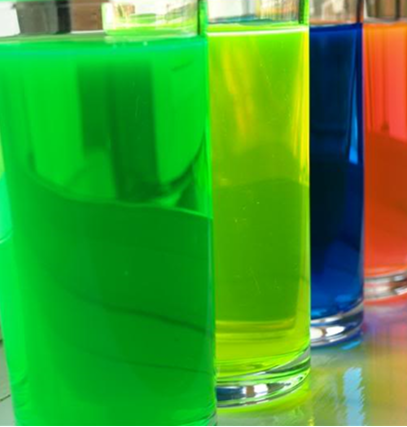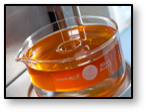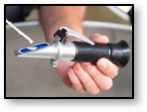Submitting Samples to the Laboratory
How to properly prepare your samples for return to the WearCheck laboratory using the new QR-coded sample information forms and poly pack mailer.

Oftentimes the predictive maintenance on cooling systems is overlooked. The failure of the cooling system, however, will likely cause a failure in the component that is being cooled (i.e. the diesel engine). Coolant analysis is an integral part of every oil analysis monitoring program, and these neglected systems require WearCheck's Coolant Analysis to monitor the cooling fluid so that the system is properly maintained and cooling system failure is mitigated.
Coolants today are more complicated than ever and are formulated with a variety of additive packages. Mixing of coolant additive technologies leads to additive drop-out (precipitate) and leaves your cooling system exposed to corrosion, cavitation and plugging, ultimately leading to a dramatic increase in operating temperatures and potential system failure. WearCheck's Coolant Analysis program determines the type of coolant in use, and monitors for corrosion and determines when the coolant properties will cause cavitation or system plugging.
WearCheck's Coolant Analysis program will ensure that the coolant properties are within specification to optimize low temperature usage, minimize system corrosion, and prevent system cavitation. WearCheck's Coolant Analysis program ensures that Supplemental Coolant Additives (SCAs) are added in the proper concentration and that cooling water top-ups are using water within the required hardness levels preventing high levels of dissolved solids that can lead to additive drop-out and cooling system plugging.
A WearCheck Technical Representative will recommend the proper test kits for your equipment. WearCheck provides you with clear and concise directions, forms and sample bottles required to submit samples to the WearCheck laboratory. After you have taken the appropriate samples of coolant from the cooling system, simply fill out the information sheet and submit the form along with your sample to the laboratory.
WearCheck’s Coolant Analysis is effectively used today for a complete range of coolants including Extended Life Coolants (ELC), hybrid coolants and conventional coolants used in cooling systems for engines, hydraulic systems and other systems requiring aqueous-based cooling fluids.
| Test | Test Method | Description | COOL1 | COOL2 |
|---|---|---|---|---|
 |
ICP Analysis ASTM D5185 |
Determines the parts per million (ppm) of all wear metals (Fe, Cr, Ni, Pb, Cu…), contaminants (Si, Na, K….), and additives (Ca, P, Zn, Mg, Mo…). | ||
 |
Color / Appearance Visual |
Pictures of color/clarity and visual debris (bottom of sample) are taken and coolant color, levels of contamination and visual problems are recorded. | ||
 |
pH Level ASTM D1287 |
Measures the pH of the coolant. Too low of a pH can cause corrosion, while too high of a pH can cause damage to gaskets and softer metal components in the cooling system. | ||
 |
% Glycol ASTM D3321 |
Determine the percentage of glycol present in the coolant by measuring the refractive index. Optimum freeze protection is achieved when the glycol percentage is between 45 and 60% of the total coolant mix. | ||
 |
Freeze Point ASTM D3321 |
The freeze point of the coolant is calculated based on the percent glycol and the type of coolant (ethylene / propylene) base in use. The freeze point determines the lowest temperature use of the coolant. | ||
 |
TDS WC Method |
Determination of the Total Dissolved Solids (TDS) present in the coolant. High TDS can cause corrosion, additive drop-out and increase bacterial growth in the coolant. | ||
 |
Nitrites WC Method |
Measures the amount of remaining supplemental coolant additives (SCAs) present in a conventional coolant. SCAs provide corrosion protection to the cooling system. | ||
 |
Reserve Alkalinity ASTM D1121 |
A determination of the remaining alkalinity reserve in a conventional coolant. The reserve alkalinity is an indication of the coolants ability to maintain an optimal pH level. | ||
 |
Carboxylates WC Method |
Test kit method for determination of carboxylates in Extended Life Coolant (ELC). Carboxylates provide protection against corrosion and cavitation so their concentration level must be monitored. |
Check with your local WearCheck laboratory regarding which specific ASTM test methods are utilized.
How to properly prepare your samples for return to the WearCheck laboratory using the new QR-coded sample information forms and poly pack mailer.
How not to submit samples to the laboratory","Common issues with samples submitted to the WearCheck laboratory are reviewed. Sample issues cause delays, and slow down the sample layout process. Please ensure that you are completing your sample forms, and properly packing your sample when sending them to the WearCheck laboratory.
WearCheck Coolant Analysis includes everything to set-up a complete Coolant analysis program. When you purchase a WearCheck Coolant analysis program you will receive our simplified sample kits (QR-coded bottles & sample forms with mailing packs). All WearCheck Coolant analysis programs include laboratory testing, sample diagnosis and recommendations, sample report, and access to our patented WebCheck™ system, and companion mobile application to manage your Coolant analysis program.
WearCheck offers additional programs for Fleet Vehicles, Off-Road Construction, Mobile Equipment, Fixed Plant Machinery, Marine Equipment, Wind Turbine Industry, Aviation/Avionics Systems, Advanced Oil Monitoring, Diesel/Marine/Jet Fuel Analysis, Thermal/Heat Transfer Fluid Analysis, Transformer Fluid Analysis, Grease Analysis, Wear Particle Analysis, Honeywell TPE-331/TFE-731 SOAP Service.